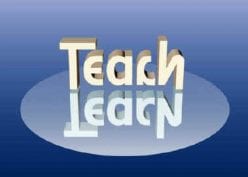How the Brain Works David Sousa

HOW THE BRAIN REALLY WORKS
- We always focus on the what (subject matter) but not the how to learn (everything) fast
- The brain— compartments
- Base of skull—primitive
- Middle brain—controls hormonal, emotions and part of LTM…strong emotions tie MEMORY LTM
- fist with hand and wrap other hand over = neocortex—thinking brain
- many neurons –its not really the number rather the connections we have between cells…intelligence is not fixed, it increasing by stimulated brain capacity…the brain expands thru use…you are the architect of your own brain…
- The brain thrives on novelty…
- The left (speech and logic, linear, sequence) and right brain (melody & pattern, global, intuitive) —the whole brain is actively involved…
- Most traditional education materials rely on linear presentation that turns off the global learners…
- Info entering our brains goes thru the middle and directs it like a switchboard to the primitive and new (neocortex). + Emotions engage and increase learning rates…
- Stress and previous poor learning experiences present threat and learning less effectively because of less brain potential available…
- LEARNING STYLES—
- 5 SENSES—AUDIO, VISUAL, KINESTHETIC, OLFACTORY, GUSTATORY
- Language uses 3 senses AVK—each brain has a preferred sequence of the combo—personal individual learning style…the knowledge of learning style makes effective learning possible…it should match that of the instructor if not then adjustments have to be orchestrated…
- MI—natural and common sense talents—personal learning style combined with natural intelligence is the key match…academic success has been the usual mode of defining intelligence…things are changing
Master steps for accelerated learning
- Develop the mindset of a champion—peak state—relaxed, alert, confident, and motivated…= efficient results, spiral of upward outfoldment—
GUIDELINES
- 5 -10 deep breaths of fresh air for inc O2, ( count and hold each breath)—
- Pleasure principle—what are the benefits, what’s in new learning for you?, reasons come first then strategies,
- Internal vs. external motivation—go internal –internal motivation = physiology (kinesthetic) + focus (visual and auditory), this changes biochemical rhythms by a loud noise, snap of fingers, staring at the sky…ask an empowering question rather than disempowering. Stay in charge of your mental focus with visual imagery.
- Listen to soothing music—master 3000 words for a new language for 3 months, that is 35 new words everyday. Master the basic and simple expressions.
- Affirmations with positive incantations…our brain works like a parachute, when open it collects more…always summarize at the end of a lesson
- Daily goals think of benefits by write a summary paragraph, set a timetable, break it into chunks, take action in peak state, celebrate after each victory, summarize and sleep over info for consolidation during REM sleep, review before each learning session.
- Discover your learning style by observing your senses…feed your brain in the same sequence that it enjoys learning…think of mind maps, highlighting, pictures, engage in conversation, touch feel and smell, move around…absorb new info in all 3 sources… remember 10% read, 20% hear, 30% see, 50 % Hear and say, 70 % say and work, 90% say as you do® learn in the accelerated form®using a multisensory approach
- Explore the subject by all of MI—intellectual knowledge is only the theoretical data and understating of subject matter; profound knowledge is – produces profound results from practice of the intellectual knowledge…something has to be done with surface knowledge.
- Get a grasp of the concept, theory, philosophy or subject matter
- Practice taking in the info in your learning style, sorting it out, org info in brain and explore with all of MI
- Realization of dreams, goals and desires…best a teacher can do is supply materials meaningfully for you to want to learn and remove obstacles…intelligence is not fixed, it can change in situs, it is simply a set of abilities and skills…it is demonstrated by what people do and achieve…you need to work to add to and improve your intelligence..>>>balanced learning…logically—break goals into small steps; linguistically—treat brain as an archive with strong grammar, vocabulary to associate with native and foreign language with VAK, record your own tapes in foreign lingo; visually—step into real-life situ with practical applications; musically—create jingles, rhymes, songs in the new lingo; physical—move around while repeated dialogue, act it out, fake it before you make it happen; interpersonal—select study partners and teach each other and have fun while practicing; intrapersonally—step back and reflect on where you are and where you want to be with the new info.
- Memory strategies –there is no learning without memory…how to go from STM to LTM—
- memorize the key facts and repetitions –but by fun filled associations with VAK, visual—where are you when learning, stimulate the imagination, read the info, watch a video, create learning maps—associate with something you already know (scaffold); auditoryassociations could be—quality of voice while repeating, musical accompaniment, natural sounds, cassettes, engage with experts, create anchors with sounds—kinestheticcan be changing physiology (position), clapping hands, snapping fingers, combos of the three for new info…NLP—forging a memory groove or pathway.
- Decide to remember
- Review cycle—forget 70 % within 24 hours without review…recap after every learning session and recap before a new one…
- Review within 1 hour
- Revise the info within 24
iii. Review within 1 Week
- 1 Month
- 6 months look at memory bank like lots of books logically organized…organize sort and put in recognizable filed
- Have fun—
- Create acronyms LUCK = labor under correct knowledge, TEAM= together everyone achieves more.
- Sleep over new info® consolidation for LTM…let the brain use the unconscious
- Memory flashing®repro the map from memory on paper
- Show you know –practice—intelligent repetition and practice…every repetition forges the info into thick branches in the memory bank.
- Reflection for constant and never-ending improvement. What are your dominant intelligences? How can you use all eight effectively. What are your favorite memory strategies? Create positive neuroassociations.
- Pick what you want to learn and make it work for you!
